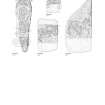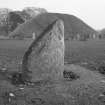Inverurie
Pictish Symbol Stone (Pictish)
Site Name Inverurie
Classification Pictish Symbol Stone (Pictish)
Alternative Name(s) Old Inverurie Churchyard; Inverurie Cemetery; Inverury No. 4; Inverurie No. 4
Canmore ID 191750
Site Number NJ72SE 11.04
NGR NJ 7802 2062
Datum OSGB36 - NGR
Permalink http://canmore.org.uk/site/191750
- Council Aberdeenshire
- Parish Inverurie
- Former Region Grampian
- Former District Gordon
- Former County Aberdeenshire
Field Visit (14 August 2000)
NJ72SE 11.04 7802 2062
(Inverurie no. 4). The Class I symbol stone Inverurie no.4 is the northernmost, and is separated from the others by the Innes of Ardtannes headstone. An unshaped block of pale pink granite with a pointed head, it measures 0.82m in breadth by 0.31m in thickness at ground level and stands 1.23m in height. On the lower half of its W face it bears the incised figure of a horse. This is depicted in motion, with left front and right rear legs raised. The mane is shown as an internal line parallel to the curve of the neck, and by three erect curved, spine-like hairs behind the ear, and by two in front. The eye is circular, with a central dot. Except for the rear hoof which has scaled away, the figure is intact.
Visited by RCAHMS (IF), 14 August 2000.
























